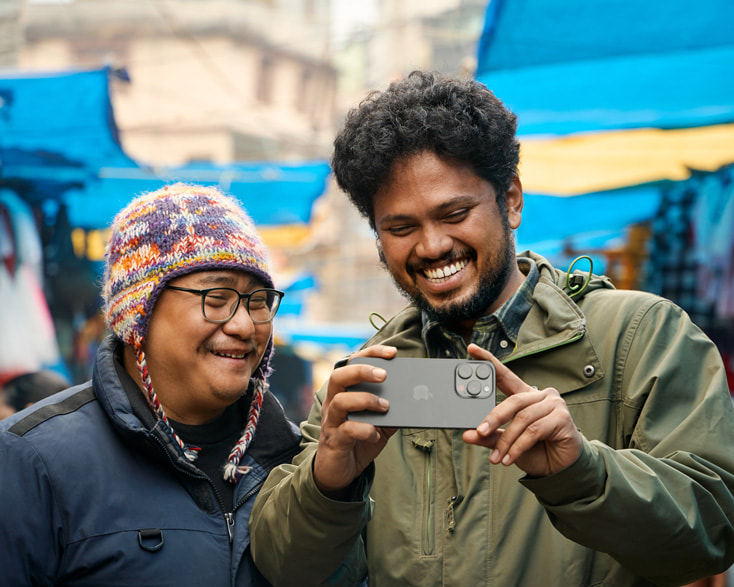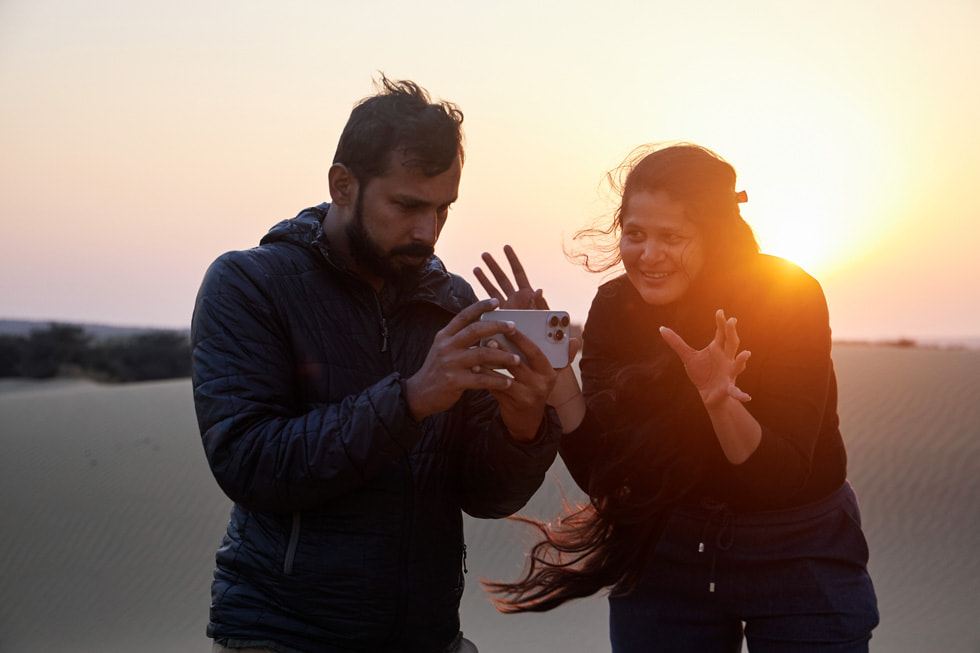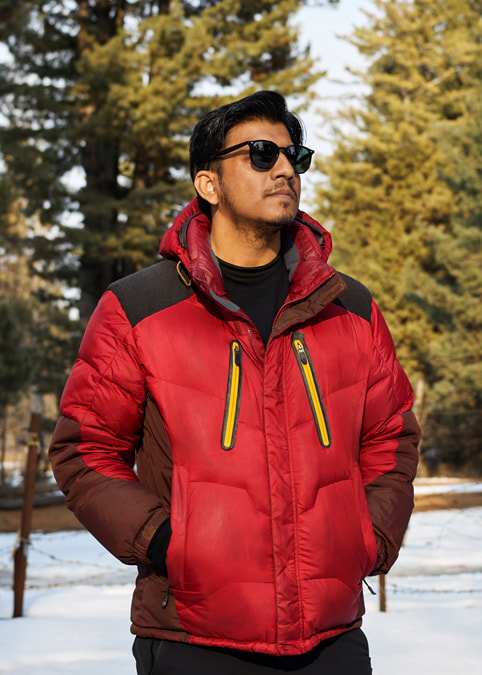


Vishal Bhardwaj — the legendary director who shot his film Fursat on iPhone 14 Pro — believes that filming with a nontraditional camera can be liberating. “You don’t need to restrain yourself with the shots, depth, or colours you capture,” he says. “If you go all out with your vision, the results will surprise you.”
19 Apr 2024

Vishal Bhardwaj — the legendary director who shot his film Fursat on iPhone 14 Pro — believes that filming with a nontraditional camera can be liberating. “You don’t need to restrain yourself with the shots, depth, or colours you capture,” he says. “If you go all out with your vision, the results will surprise you.”
Alongside fellow industry icons Vikramaditya Motwane and Rohan Sippy, Bhardwaj is mentoring five emerging filmmakers that were selected by the Mumbai Academy of Moving Image (MAMI) to create short films for the 2024 MAMI Select — Filmed on iPhone program.
Anupama Chopra, director of the prestigious MAMI Mumbai Film Festival, says, “Our aim is to create an ecosystem that facilitates emerging filmmakers by creating opportunities that help them do new work and showcase it to a larger audience. MAMI Select — Filmed on iPhone is an important initiative in that direction, and we cannot wait for the world to see these stories using the filmmaking capabilities of iPhone 15 Pro Max and the editing prowess of MacBook Pro with M3.”
The filmmakers — Saurav Rai, Archana Atul Phadke, Faraz Ali, Saumyananda Sahi, and Prateek Vats — are reimagining traditional cinematic conventions by shooting on iPhone 15 Pro Max. Each filmmaker is also using MacBook Pro with the M3 Max chip, allowing them to edit in even the most remote locations.
“Whatever story you have inside of you can now be told with the device you carry around with you all day,” says Motwane. “iPhone is a real boon for filmmakers. It gives everybody a chance to shoot great things.”
All five of their short films will premiere on the MAMI YouTube channel on April 19, 2024 (local time).
Up in the picturesque mountains of Darjeeling, Saurav Rai believes that the only stories worth telling are the ones he has lived. Gudh (Nest) — Rai’s debut film that was an official selection at the 69th Cannes Film Festival in 2016 — was inspired by his own childhood memories.
His new film, Crossing Borders, is no exception. Inspired by his aunt, it tells the story of a woman who smuggles goods, like saris and umbrellas, across the Indo-Nepalese border to make ends meet. “I can’t work with feelings that I’ve not experienced firsthand,” he explains.
Exploring themes like immigration and identity, the film’s plot sees the protagonist pretend to be the mother of two children she encounters during her smuggling escapades.
“The kids don’t have identity cards on them,” he says. “They have to prove their relationship to the authorities in order to get back home.”
With the motif of hyperreality defining his style, Rai prioritises simplicity in his process. “We shoot on iPhone 15 Pro Max and then send it for colour correction,” he says. “No fuss, no gimmicks.”
Having used Apple products for a long time, Rai believes iPhone 15 Pro Max is made for filmmakers. Cinematic mode keeps his richly developed characters in sharp focus while blurring the foreground or background. “Shooting like this gives you a beautiful depth of field that you can control either in post or on the iPhone itself,” he explains.
For her short film, Archana Atul Phadke found aural inspiration in the rhythmic hum of the windmills outside Jaisalmer. Titled Mirage, the film is based on a young boy who spends all his time on his iPhone, only to lose it — and himself — in the desert.
“My films always start with music or sounds,” says the National Award winner and alumna of the Berlinale Talent Campus. “The visuals come later.”
Phadke likes to hold shots long enough for the audience to bring their own feelings into them. “I hope the empty desert landscape makes people conscious about the fact that they’re breathing,” she says.
To juxtapose the vast landscape against her fledgling protagonist, Phadke is using the native cameras of iPhone 15 Pro Max to compress and decompress her visual storytelling. “With the default 24 mm Main camera, I explore wide shots in the beginning,” she explains. “Towards the end, the 120 mm Telephoto camera — which gives amazing depth — makes the boy’s world smaller and smaller.”
"Editing is like creating music. There’s a natural rhythm to a scene, and you want to cut every shot to that beat. Thanks to the crazy-good render times, I can keep my flow intact while stitching it all together."
-Archana Atul Phadke, filmmaker

The smaller form factor of iPhone 15 Pro Max has been a revelation for Phadke when working with kids with little to no acting experience. “A massive camera might overwhelm them, but they are totally at ease in front of an iPhone.”
Out in the desert, Phadke is shooting in a completely wireless ecosystem: She uses her Apple Watch to operate and monitor the iPhone camera, while an iPad serves as a larger monitor, and AirPods let her check the sound before she moves into editing on her MacBook Pro with M3 Max.
“Editing is like creating music. There’s a natural rhythm to a scene, and you want to cut every shot to that beat,” says Phadke. “Thanks to the crazy-good render times, I can keep my flow intact while stitching it all together.”
Filmmaker Faraz Ali's introduction to world cinema was quite literally incomprehensible to him.
“They would show Iranian movies on television without subtitles,” reminisces Ali, who grew up in the '90s. “I was intrigued by the universal language of cinema. I feel the same curiosity now about shooting with iPhone 15 Pro Max.”
A writer and advertiser, his debut film Shoebox won Best Film at the New York Indian Film Festival in 2022. It is an exploration of memory, a subject that permeates his new project as well.
Titled Óbur (Cloud), the tragicomedy follows a teenage boy who loses the memories of his ailing mother. The memories were on his iPhone, which he pawns off to a pharmacist in exchange for his mother’s medical aid.
Óbur is Ali’s latest exploration of milieux, another trademark of his storytelling. He believes that iPhone 15 Pro Max lets him go where filmmakers with bigger cameras simply cannot — like the snowy white peaks of Kashmir, where colour is king.

“Colour can tip the scale towards tragedy or comedy,” he explains. “ProRes video with Log encoding gives my grading artist and I the raw materials we need to find that delicate balance.”
Equally important to the atmosphere is the aural landscape. For this film, Ali is recording ambient sounds on iPhone 15 Pro Max using the Voice Memos app and an external mic. On Mac, he also uses Final Draft to work on his scripts, as well as Adobe Photoshop to colour grade stills during preproduction.
While Ali’s childhood revolved around cinema, Saumyananda Sahi — the cinematographer behind the BAFTA- and Academy Award-nominated documentary All That Breathes — never really saw a film for the first decade of his life.
“I was 11 when my elder brother brought home a television and VHS player for the first time,” recalls Sahi. Enamored by the films of Ingmar Bergman and Andrei Tarkovsky, Sahi trained at the prestigious Film and Television Institute of India (FTII). This is where he met Tanushree Das, his future wife and co-director of A New Life, their short film for MAMI Select — Filmed on iPhone.
Its narrative follows a migrant factory worker who leaves behind his pregnant wife in search of better job opportunities. Shot in Kolkata and Bengaluru, it examines tropes of fatherhood and long-distance relationships.
Like a modern-day epistolary, the story plays out via video calls between the couple. Having shot titles like Trial By Fire to great acclaim, Sahi chose to cede control of the camera to his actors this time around.
“It’s a lot of fun!” he says eagerly. “We’re shooting the video calls in real time, and iPhone is a part of the performances. That kind of storytelling is only possible here.”
Sahi isn’t treating iPhone like a phone at all. “I can peg exposure or shoot Log like I usually do on an Arri Alexa cinema camera,” he explains. “It’s amazing that iPhone 15 Pro Max can live up to all that.”
Sahi’s skill with the camera came to the fore for Eeb Allay Ooo!, the breakout film of Prateek Vats.
“Born in 1984, mine is a generation that has left the past but not yet reached the promised future,” says Vats. “My creative tension is rooted in this insecurity.”
The short film he is co-directing with Shubham is inspired by Anton Chekhov’s short story The Death of a Government Clerk. Titled Jal Tu Jalal Tu (You Are Water, You Are the All-Powerful), it captures the anxiety of a factory worker who accidentally offends his employer. The film delves into power dynamics and social hierarchies in a blue-collar environment.
Vats is shooting the film in a 4:3 aspect ratio, which harks back to box television sets from the '90s. By using the 24 mm Main camera of iPhone 15 Pro Max, he frames character portraits that allow the audience to see them through his eyes.
Set in a real garment factory in Sonipat, the film is “a riot of colours that iPhone 15 Pro Max captures perfectly,” says Vats. He is leveraging the device’s ProRes Log recording capabilities by precisely tuning specific areas in terms of exposure and colour.
Vats is optimistic about the long-term impact of iPhone on Indian filmmaking: “When anyone with a vision — irrespective of their background — is empowered to make films, the storytelling potential of this country will really blossom.”
Share Article: